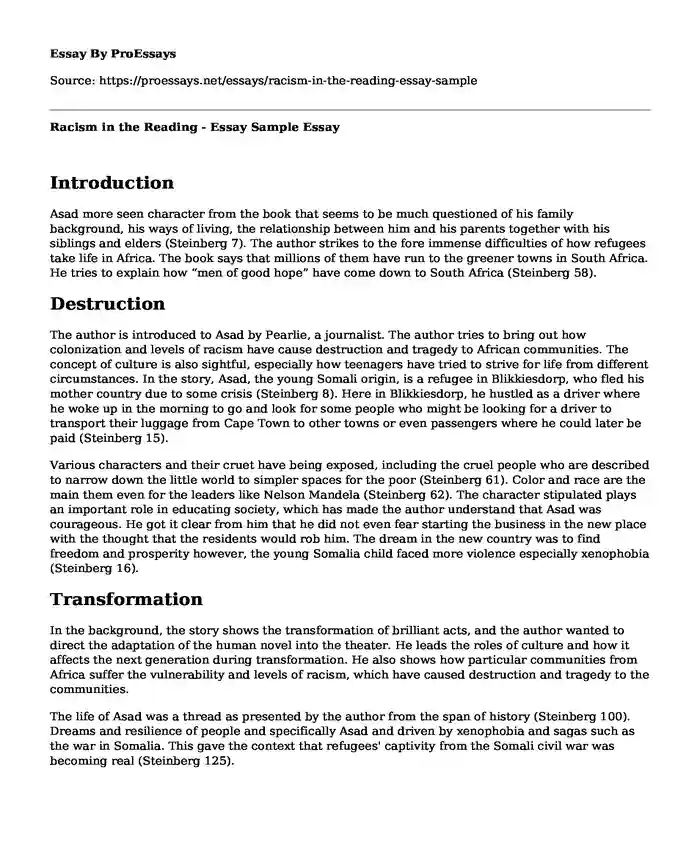Introduction
Asad more seen character from the book that seems to be much questioned of his family background, his ways of living, the relationship between him and his parents together with his siblings and elders (Steinberg 7). The author strikes to the fore immense difficulties of how refugees take life in Africa. The book says that millions of them have run to the greener towns in South Africa. He tries to explain how “men of good hope” have come down to South Africa (Steinberg 58).
Destruction
The author is introduced to Asad by Pearlie, a journalist. The author tries to bring out how colonization and levels of racism have cause destruction and tragedy to African communities. The concept of culture is also sightful, especially how teenagers have tried to strive for life from different circumstances. In the story, Asad, the young Somali origin, is a refugee in Blikkiesdorp, who fled his mother country due to some crisis (Steinberg 8). Here in Blikkiesdorp, he hustled as a driver where he woke up in the morning to go and look for some people who might be looking for a driver to transport their luggage from Cape Town to other towns or even passengers where he could later be paid (Steinberg 15).
Various characters and their cruet have being exposed, including the cruel people who are described to narrow down the little world to simpler spaces for the poor (Steinberg 61). Color and race are the main them even for the leaders like Nelson Mandela (Steinberg 62). The character stipulated plays an important role in educating society, which has made the author understand that Asad was courageous. He got it clear from him that he did not even fear starting the business in the new place with the thought that the residents would rob him. The dream in the new country was to find freedom and prosperity however, the young Somalia child faced more violence especially xenophobia (Steinberg 16).
Transformation
In the background, the story shows the transformation of brilliant acts, and the author wanted to direct the adaptation of the human novel into the theater. He leads the roles of culture and how it affects the next generation during transformation. He also shows how particular communities from Africa suffer the vulnerability and levels of racism, which have caused destruction and tragedy to the communities.
The life of Asad was a thread as presented by the author from the span of history (Steinberg 100). Dreams and resilience of people and specifically Asad and driven by xenophobia and sagas such as the war in Somalia. This gave the context that refugees' captivity from the Somali civil war was becoming real (Steinberg 125).
Conclusion
In summary, the author shows the things we believe and how they make us human with different possessions, how generations of siblings have gone from one generation to the next—the suffering they face with dreams and desires to leave something tangible. The author presents the different contexts of different places like Johannesburg, South Africa, which is believed to have streets with opportunities referred to as gold.
Work Cited
Steinberg, Jonny. A man of good hope. Vintage, 2015. 1-172.
Cite this page
Racism in the Reading - Essay Sample. (2024, Jan 11). Retrieved from https://proessays.net/essays/racism-in-the-reading-essay-sample
If you are the original author of this essay and no longer wish to have it published on the ProEssays website, please click below to request its removal:
- How Chaucer's General Prologue Introduces the Canterbury Tales: Essay Example
- A Situation Online Where I Witnessed Online Trolling and Flaming - Essay Sample
- Paper Example on Casino Gambling
- Distracted Driving: A Successful Intervention Program
- Essay Example on White Male Privilege: Unearned Advantages & Dominance
- Gender Imbalance: Examining US Perspectives - Essay Sample
- Paper Example on Understanding Addicts: Educate Yourself to Help a Loved One







